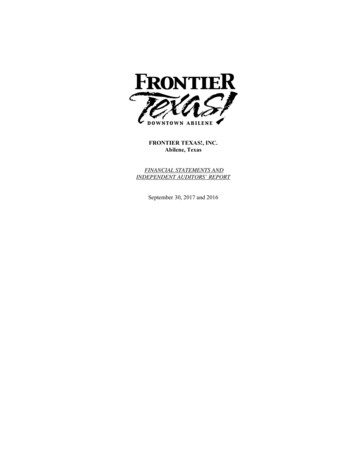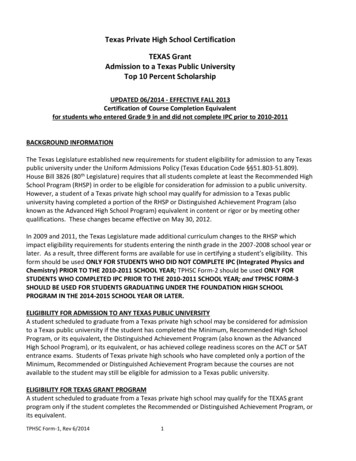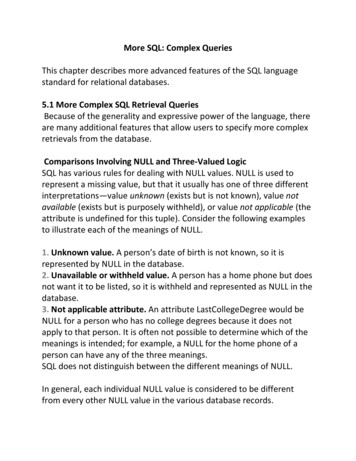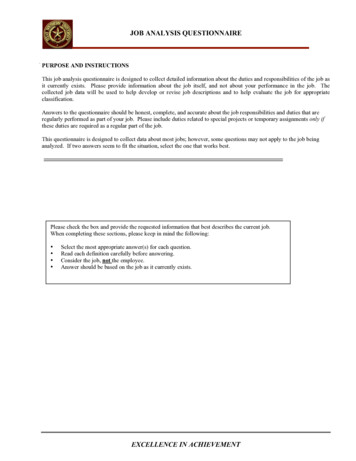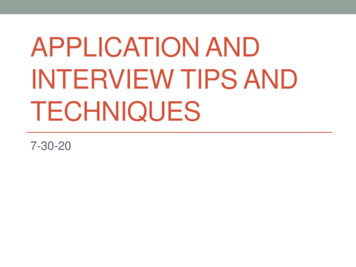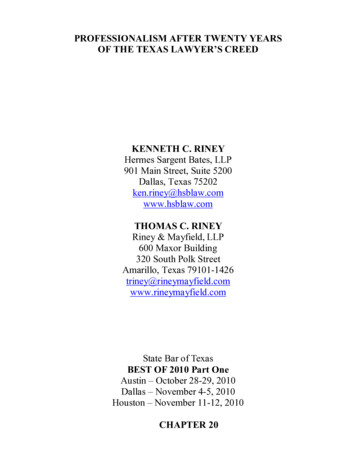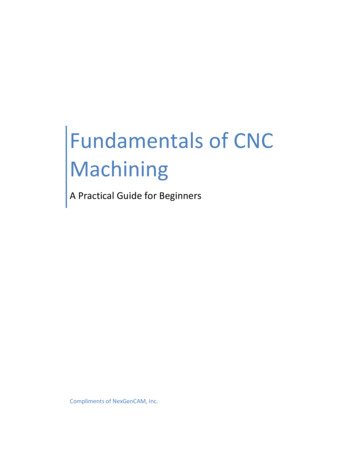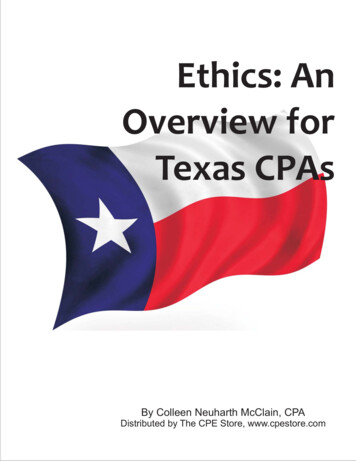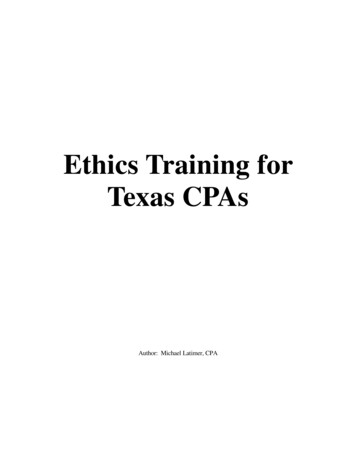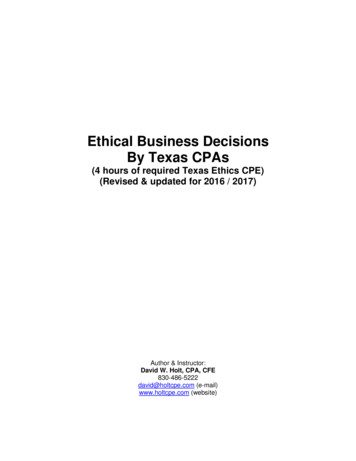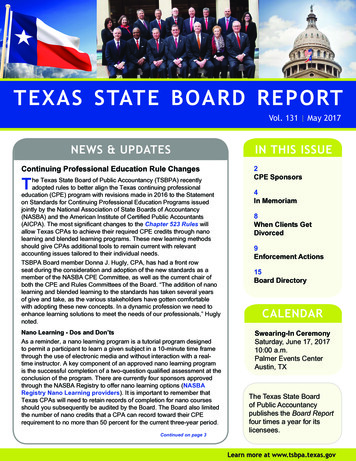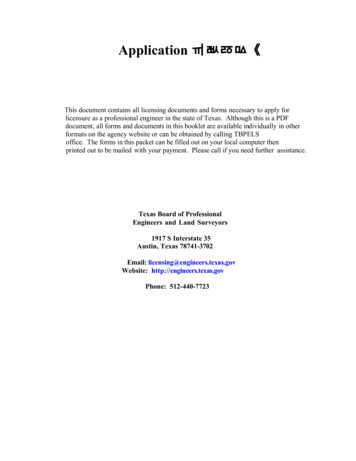
Transcription
Application 3DFNHWThis document contains all licensing documents and forms necessary to apply forlicensure as a professional engineer in the state of Texas. Although this is a PDFdocument, all forms and documents in this booklet are available individually in otherformats on the agency website or can be obtained by calling TBPELSoffice. The forms in this packet can be filled out on your local computer thenprinted out to be mailed with your payment. Please call if you need further assistance.Texas Board of ProfessionalEngineers and Land Surveyors1917 S Interstate 35Austin, Texas 78741-3702Email: licensing@engineers.texas.govWebsite: http://engineers.texas.govPhone: 512-440-7723
TEXAS BOARD OF PROFESSIONAL ENGINEERS AND LAND SURVEYORSLicensure As A Professional Engineer In TexasWho Should be LicensedUnder the Texas Engineering Practice Act, only duly licensed persons may legally perform, or offer to performengineering services for the public in Texas. Furthermore, public works must be designed and constructedunder the direct supervision of a licensed professional engineer. The terms "engineer" or "professionalengineer" can only be used by persons who are currently licensed. Anyone who violates these parameters issubject to legal penalties.Purpose & HistoryThe Engineering Registration Act (Article 3271a, V.A.T.S.) was enacted as the result of a tragic schoolexplosion at New London, Texas, in 1937. In response to concerns that the public could not identify who wasqualified to practice engineering, the 45th Texas Legislature passed the Act as emergency legislation and itbecame law when signed by the Governor on May 28, 1937. The 59th Texas Legislature rewrote the originalRegistration Act. This Act became law on August 30, 1965, and was called the "Texas Engineering PracticeAct."The authors of the Texas Engineering Practice Act included the following statement in Section 1001.004 of theAct:“The legislature recognizes the vital impact that the rapid advance of knowledge of themathematical, physical, and engineering sciences as applied in the practice ofengineering has on the lives, property, economy, and security of state residents and thenational defense. The purpose of this chapter is to: protect the public health, safety, andwelfare; enable the state and the public to identify persons authorized to practiceengineering in this state; and fix responsibility for work done or services or actsperformed in the practice of engineering.”It therefore becomes apparent that this legislation was not enacted to restrict the number of practitioners, butrather to "safeguard life, health, and property and protect the public welfare."The Texas Board of Professional Engineers and Land Surveyors is authorized and required to license thoseindividuals who are qualified by law to practice engineering, and to regulate the practice of engineering inTexas. To accomplish this mission, the Legislature further empowered the Board to make and enforce therules dealing with licensing, compliance and enforcement, and standards of conduct and ethics.Contacting the BoardThe Board office is located at 1917 S Interstate 35 in Austin.Send all mail to:Texas Board of Professional Engineers and Land Surveyors1917 S. Interstate 35, Austin, TX 78741-3702TBPE website: http://engineers.texas.govLicensing questions may be directed to: licensing@engineers.texas.govBoard telephone numbers are: (512) 440-7723 and (512) 442-1414/FaxOffice hours are from 8:00 a.m. to 5:00 p.m., Monday through Friday, except for state and federal holidays.Revised 11/2019Page 1 of 5
Basic Requirements for LicensureThere are three basic categories of requirements that must be met for licensure: education, experience, andexaminations.Education - You must have earned one of the following degrees or degree combinations:1) An accredited degree in engineering from an EAC/ABET accredited program in the United States orequivalent. Qualifying degree may be an undergraduate degree or an advanced degree issued by a programwith an undergraduate program in the same discipline.Equivalent degrees include:A) Degrees from US programs specifically reviewed and approved by the Board;B) Degrees from engineering programs covered by the Washington Accord, an international agreementbetween ABET and similar accrediting organizations from other countries;C) Degrees from programs accredited by the Consejo de Acreditacion de la Ingenieria, Mexico;D) Degrees held by engineers currently licensed in Canada; andE) Foreign degrees from programs not covered by B) - D) above which are deemed equivalent by oneof the Board approved evaluation service providers.2) A non-accredited degree:A) An engineering degree from a US program at a recognized institution of higher learning that doesnot meet the conditions of 1) above;B) A degree in engineering technology from an ETAC/ABET accredited program; orC) A US degree in mathematical, physical, or engineering science approved by the Executive Director.All degrees or combination of degrees must have at least:8 hours of math beyond trigonometry (courses such as calculus and differential equations) and,20 hours of engineering sciences (courses such as mechanics, thermodynamics, electrical & electroniccircuits, materials science, transport phenomena, computer engineering, etc.).Contact the Licensing staff if you have questions regarding your educational credentials.Experience - You must meet the following experience requirements prior to submitting your application to theBoard:1. With an accredited engineering degree you must have 4 years or more of active practice in engineeringwork, of a character satisfactory to the Board, indicating that you are competent to be placed in responsiblecharge of such work. This experience must demonstrate a clear use of your engineering knowledge,engineering education, and engineering judgment to perform the task, be progressive, of an increasingstandard of quality and responsibility in one dominant discipline. Although it is recommended that theengineering experience be obtained while working under the supervision of a licensed professional engineer,this is not a requirement for licensure.2. With a non-accredited degree you must have 8 years of active practice in engineering work, of a charactersatisfactory to the Board.During your first few years of experience after graduation, it is imperative that you place an emphasis ongaining experience that is acceptable for licensing purposes. Failure to become licensed can severely limityour potential professional growth.While gaining experience, it is equally critical that you document it in such a way that you can summarize it forthe Board. As you go about your weekly tasks, you should keep a detailed diary of your activities: the startingand ending dates of the project(s) on which you worked, name and address of each employer, job title(s), thename, present addresses and phone numbers of the engineers and other persons with which you personallyRevised 11/19Page 2 of 5
worked who can serve as a reference to substantiate your experience, identification of the project, the scope ofthe project, and the engineering activities that you personally performed.When you are ready to apply for licensure, this information will be transferred from your diary into a summarycalled the Supplementary Experience Record (SER). It should range from about 6 to 12 pages and adequatelydescribe the engineering activities that you have performed for your entire engineering career, starting with thefirst engagement after graduation from college. The SER is to be written in the first person describing in activeengineering verbs the engineering work you specifically designed, calculated, evaluated, analyzed, etc.Experience that is considered most acceptable for licensure purposes generally falls into one of twocategories: design or analysis.The most common type of acceptable experience is design. The common denominator in all design is theselection and use of recognized engineering principles and methodology to determine a solution to a problem.The final result of design work will almost always be details, plans, or specifications for use in creating afinished product.The second common type of acceptable experience is analysis. Common features of analysis activities includethe use of mathematical modeling or review of established design standards to assess a problem or proposal,and the act of making a learned recommendation based on analytical findings. An engineering analysis activitywill result in a conclusive report and recommendation.It should be noted here that many other types of activities will also be acceptable if your participation in thoseactivities can be described in terms of design or analysis. By asking yourself if you can describe your activity interms such as "I calculated., I designed., I analyzed., I recommended.," you can almost assure yourselfthat you are describing design and analysis.References - You are required to submit at least three confidential reference statements to the Board, fromcurrently licensed professional engineers who are familiar with the work you describe in your SER. If you areapplying for an original license and requesting an examination waiver you must submit five references, whichmust be from currently licensed professional engineers. You will choose the engineers to request referencesfrom. You should be aware that it is within an engineer’s perogative to provide a reference if he or she iscomfortable giving one. The reference provider will provide the Board with an assessment of your characterand suitability for licensure and will verify the quality and scope of the work that you describe in your SER onthe Reference Statement Form. The references do not all need to be from supervisors. A professionalengineer who is familiar with your work, but may not be your supervisor will be acceptable as a reference.Professional engineers who can vouch for your character, but do not have personal knowledge of yourengineering experience may review and judge your documented experience and serve as a reference. Suchreview will be documented on the Reference Statement Form.One year of experience credit may be granted for each advanced (post-baccalaureate) engineering degree ifthe applicant has a degree in engineering and the advanced degree(s) are from an engineering program whichhas an accredited undergraduate program as described in section 1) of the education requirements above.Experience credit for all advanced degrees is limited to two years. Official transcripts are required to claim thiscredit, but SERs and references for this period are not necessary.Examinations – To qualify for licensure, all applicants must take and pass three examinations:1) The National Council of Examiners for Engineering & Surveying (NCEES) Fundamentals ofEngineering (FE) examination;2) The NCEES Principles and Practice of Engineering (PE) examination; and3) The Texas Engineering Professional Conduct and Ethics Examination.The PE examination is an 8-hour test and is given twice a year at various locations in Texas (certain PE testsare given only once per year). The PE exam testing dates are scheduled for April and October.Revised 11/19Page 3 of 5
FE Exam –The FE exam is a computer-based exam administered by NCEES. The FE examination is a suppliedreference examination consisting of a morning and afternoon session. The FE exam is discipline specific. Allcandidates take the morning section, which consists of questions common to all disciplines. The afternoonsession is administered in six disciplines and a general engineering section. The candidate will choose whichsection to work in the afternoon session. The FE format and specifications may be viewed/printed from theNCEES website at: http://www.ncees.org.The Board expects all applicants to be able to pass the exams. The Board may, at its discretion, waive the FEexamination for well qualified applicants who provide a written request submitted with an application forlicensure, do not pose a threat to the public health, safety, or welfare, and have:(a) an accredited degree and 8 or more years of engineering experience, or(b) a non-accredited degree and 12 years of engineering experience, or(c) a current Engineering Educator at a recognized institution of higher education with a Ph.D. inengineering from a program with an EAC/ABET accredited undergraduate program or equivalent.All requests for waiver of the FE will be subject to review by the Executive Director and may be reviewed byBoard members. Requests for waiver (even those meeting the above guidelines) may be denied.PE Exam –The Principles and Practice of Engineering examination is a test offered in a specific discipline of engineering.You will be granted permission to take the PE exam only after your application for licensure has beenapproved. You may test in any of the following disciplines:Agricultural (October only)Architectural (April only)ChemicalCivilControl Systems (October only)Electrical and ComputerEnvironmentalFire Protection (October only)Industrial (April only)MechanicalMetallurgical (October only)Mining/Mineral (October only)Naval Architecture & Marine (April only)Nuclear (October only)Petroleum (October only)Software Engineering (April only)Structural 16 HourThe examination formats and specifications may be viewed/printed from the NCEES website at:http://www.ncees.orgThe Board expects all applicants to be able to pass the PE exam that relates to his or her discipline. The Boardmay, at its discretion, waive the PE examination for well qualified applicants who provide a written requestsubmitted with the application, do not pose a threat to the public health, safety, or welfare, and are:1) A former Texas license holder or an engineer currently licensed in another US jurisdiction with:(a) an accredited degree and 12 or more years of engineering experience; or(b) a non-accredited degree and 16 years of engineering experience; or2) A current Ph.D. Engineering Educator (as defined by Board rules) who has qualifying engineeringexperience teaching in an EAC/ABET program for at least eight years or has at least eight years of engineeringexperience consisting of an acceptable combination of other creditable engineering experience or EAC/ABETteaching experience. Only teaching of engineering which began prior to September 1, 2001 may be countedas qualifying engineering experience.All requests for waiver of the PE will be reviewed by Board members. Requests for waiver (even thosemeeting the above guidelines) may be denied.The Texas Engineering Professional Conduct and Ethics Examination is a self-administered examinationconcerning the Texas Engineering Practice Act and the Board Rules. It should be completed by the applicantand submitted with the application.Revised 11/19Page 4 of 5
Applying for LicensureThe process of applying for licensure is rather time-consuming and you should give yourself plenty of lead-timeprior to the date that you wish to have the application submitted. Once the complete application is submitted,allow 2-3 months for processing. Incomplete applications or those requiring Board review may take longer.Once the Board approves you to take the PE examination, you will be allowed to pay the examination fee andschedule the next examination before the deadline. These deadlines are about 8 weeks before theexamination.The following is a checklist of activities that you must perform to complete the application process:1. Evaluate your education and determine the category under which you qualify for licensure. If you believethat you may have any deficiencies or if you need an evaluation to see if you meet the minimum educationrequirements, you should contact the TBPE. Application fees are non-refundable.2. Take and pass the Fundamentals of Engineering (FE) examination or request a waiver. If you have not doneso, you should contact the Board (or your school, if you have not graduated) as soon as possible and begin theprocess. The FE examination is offered by NCEES; and registration deadlines are set well in advance.Deadlines are posted on the NCEES website.3. Evaluate your engineering experience. Again, if you believe that you have any deficiencies, you shouldcontact the TBPE for help. DO NOT ANTICIPATE EXPERIENCE. The minimum experience must be earnedprior to application submittal. Applications submitted when claimed experience prior to the date of submittal isless than the minimum requirements may be denied.4. Request references from PEs. You must have at least three, but may need more depending on thecircumstances of your experience. You must send your reference providers a copy of your signed SER. Keepthe original to submit with the application.5. Contact your university and request official transcripts. Official transcripts (marksheets and diplomas) are tobe sent from the issuing institution directly to the Board. Student copies are not acceptable.6. Complete your application as instructed. The application form must be typed (not hand-written). Applicantswith foreign degrees or other unique situations should be aware that there may be additional requirementssuch as Test of English as a Foreign Language (TOEFL), and degree evaluations.7. Complete the Texas Engineering Professional Conduct and Ethics Examination and submit the answersheet or results with the application.8. Applicants who have taken and passed the FE and/or PE exam in another US jurisdiction will not have totake them again in Texas, but will be required to obtain verification of those exams from the appropriatejurisdiction or NCEES to be sent directly to the TBPE.9. The application fee is 80.Should you have any questions, please contact the Board office.Revised 11/19Page 5 of 5
Payment CouponFailure to include the coupon below may result in a delay inthe processing of your application.Be sure to detach the coupon below and include it with yourpayment and application.Texas Board of Professional Engineers and Land SurveyorsPE Application PaymentName (Please print)Social Security NumberPlease do not write in this area.000000 08000 03 0Email AddressAmount Due 80
Application Information ChecklistFor an application to be considered complete, you must include the following items.Note that your application will not begin processing until items #1-4 have been received.Items 1-4 must be sent to the board from the APPLICANT:1 ) Complete four (4) page application form (Form EB-04)*2) Original SER (Form EB-13) - Signed by APPLICANT ONLY1) Submit one complete copy of your SER with your application form.2) Provide copies to reference providers to co-sign (See #6 & #7 below)3) Completed Texas Engineering Professional Conduct and Ethics Exam Answer Sheet (Form EB-01) or thepassing scoresheet if you completed the exam online.4) 80 Application Fee (Don't forget the payment coupon with your check or money order.)Item 5 must be sent directly to the board from the EDUCATIONAL INSTITUTION:5) Transcript(s)*Items 6 & 7 must be sent to the board by one of the following methods: 6)Collected by applicant and sent in all at once with the applicationSent directly to the PE Board by the references themselves(See Board Rule 133.51 for number of references required) Completed reference statement signed by reference provider (Form EB-15)*Each Reference Provider is REQUIRED to:- Place SER and REFERENCE STATEMENT in an envelope and seal it.- SIGN the flap of the envelope.- Place a piece of transparent tape over the signature for confidentiality.- Include a copy of pocket card or other proof of licensure if non-Texas PE*7) Copy of SER signed by applicant AND reference provider (Form EB-13)8) All applicants must comply with the criminal history record check requirements. See Board Rule 133.21 andSection 1001.3035 of the Act. Refer to the website: https://engineers.texas.gov/recordcheck.html for additionalinformation.9)Inclu
2) The NCEES Principles and Practice of Engineering (PE) examination; and. 3) The Texas Engineering Professional Conduct and Ethics Examination. The PE examination is an 8-hour test and is given twice a year at various locations in Texas (certain PE tests are given only once per year). The PE

